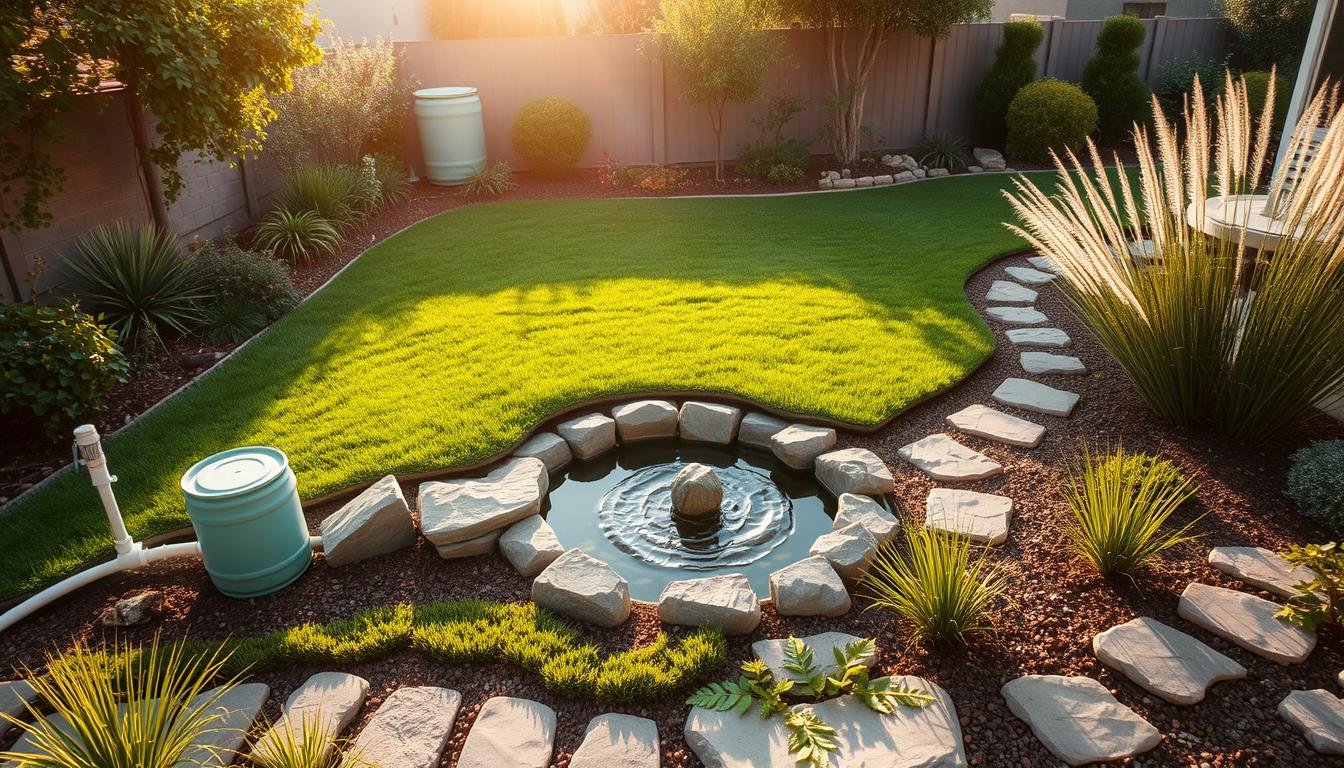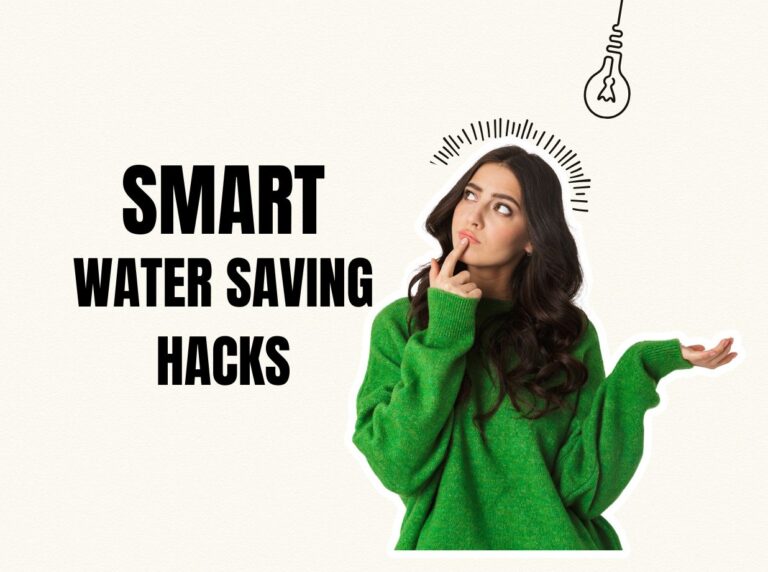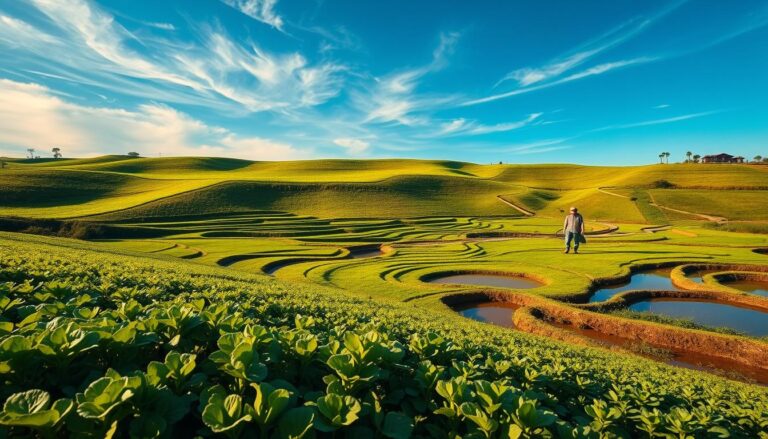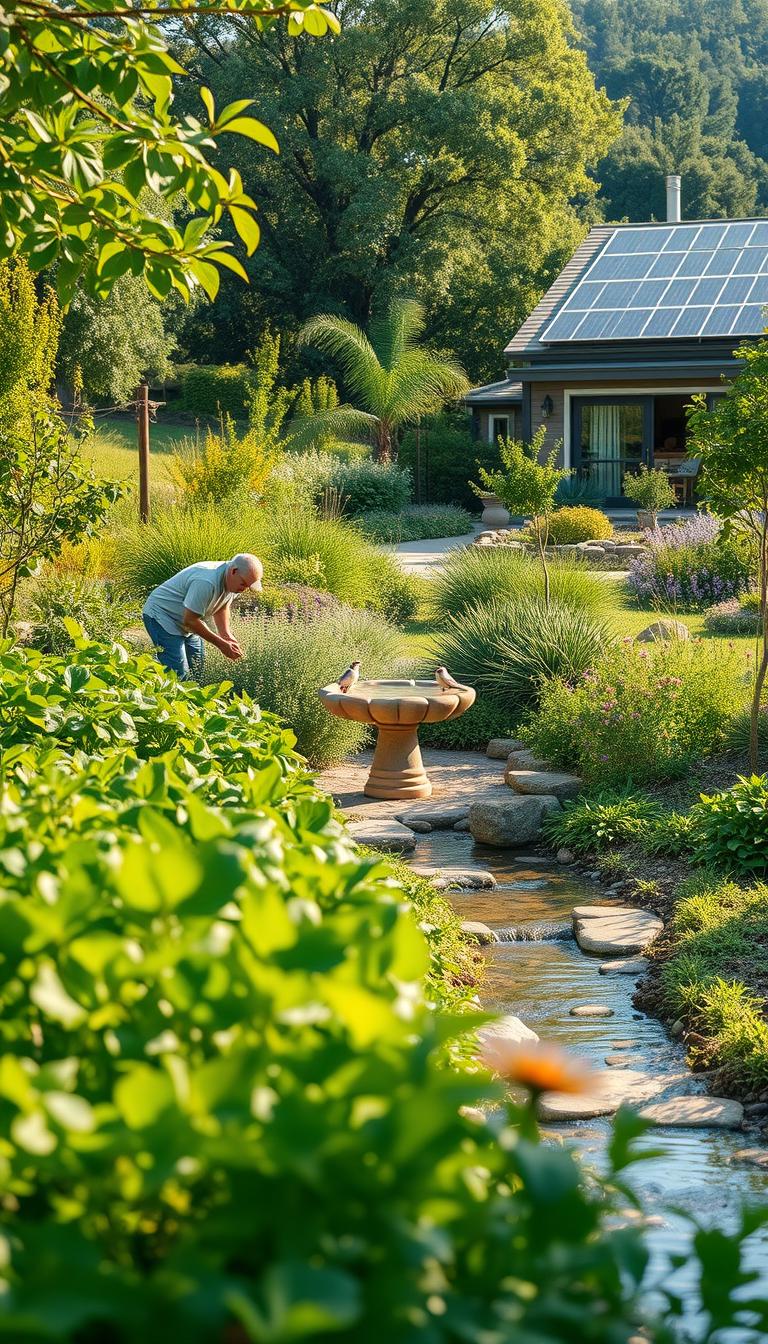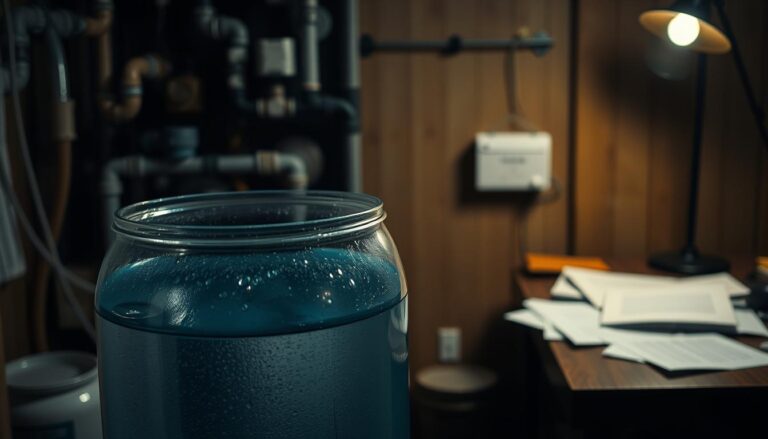Homeowner’s Guide to Efficient Water Management
Did you know the United Nations Educational Scientific and Cultural Organization says we need 20 to 50 litres of water daily? This shows how crucial efficient water management and saving water are.
As a homeowner, you can make a big difference by following simple yet effective water conservation tips. By adopting smart water habits, you help create a greener future.
Key Takeaways
- Understand the importance of efficient water management
- Learn simple water conservation tips for homeowners
- Discover how to develop smart water habits
- Contribute to a more sustainable future through water conservation
- Reduce your water consumption with effective management strategies
The Growing Water Crisis in America
America’s water crisis is getting worse, threatening the future of sustainable water usage. It’s important to know about water shortages and how they affect water rates at home.
Current Water Shortage Statistics
The latest water shortage data is alarming. 2025 has seen a big jump in droughts in many places.
2025 Drought Conditions Update
The drought in 2025 is one of the worst ever. Large parts of the country are facing severe to extreme drought.
Regional Water Stress Indicators
Water stress is high in areas like the Southwest. This is due to long droughts and too much groundwater use.
| Region | Drought Severity | Water Stress Indicator |
|---|---|---|
| Southwest | Extreme | High |
| Northeast | Moderate | Low |
| California | Severe | Very High |
Impact on Residential Water Rates
The water crisis is making water rates at home go up. Many places are seeing big price hikes.
Recent Utility Price Increases
Utility companies are raising prices because of the water shortage. This is making it harder for families to budget. It’s leading people to look for water conservation tips.
Understanding the water crisis helps homeowners save water at home. This way, they can help make a more sustainable future.
Understanding Your Home’s Water Consumption
Knowing how much water your home uses is key to saving money and water. Start by looking at your water bills. Then, find out where water is wasted in your home.
How to Read Your Water Bill
Your water bill has important info on your water use. Learning to understand this data is crucial.
Decoding Usage Metrics
Your bill shows how much water you used in a certain time. It’s usually in gallons or cubic feet.
Comparing to Regional Averages
Many water companies compare your use to the average. This helps you see if you’re using more than usual.
Identifying High-Usage Areas
Some parts of your home use more water than others. Knowing where can help you save.
Room-by-Room Assessment
About 65% of home water use is in the bathroom. This is mainly from flushing toilets and taking baths. A room-by-room check can show where to save water.
| Room | Typical Water Usage | Conservation Opportunities |
|---|---|---|
| Bathroom | Toilet flushing, bathing | Low-flow toilets, showerheads |
| Kitchen | Drinking water, cooking, washing dishes | Water-efficient appliances, fixing leaks |
| Laundry | Washing clothes | Water-efficient washing machines |
Smart Water Habits Every Homeowner Should Know
Homeowners can make a big impact on water conservation by adopting smart habits. Simple daily practices can cut down water use. This not only saves water but also lowers your water bills.
Daily Conservation Practices
Starting with daily habits is key to efficient water use. Small actions can lead to big changes.
Five-Minute Shower Challenge
Shorter showers are a great way to save water. The five-minute shower challenge can cut down water use by a lot. Timing your showers can save up to 20 gallons a day.
Full-Load Appliance Operation
Using appliances like dishwashers and washing machines with full loads saves water. This ensures water is used efficiently, reducing overall use.
Seasonal Adjustments for Water Usage
Adjusting water use with the seasons is important for efficient water management. Each season needs its own approach.
Summer Conservation Strategies
In summer, water lawns and gardens in the early morning or late evening. This cuts down on evaporation. Using drought-resistant plants also helps save water.
Winter Efficiency Measures
In winter, insulate exposed pipes to prevent freezing and bursting. This saves a lot of water. Fixing leaky faucets and plumbing also saves up to 20 gallons a day, as energysavers.gov reports.
| Season | Conservation Strategy | Potential Savings |
|---|---|---|
| Summer | Watering during cooler parts of the day | Up to 10 gallons per day |
| Winter | Insulating exposed pipes | Up to 20 gallons per day |
Indoor Water Management Strategies
Reducing indoor water usage is possible with smart strategies. By using efficient water management in the kitchen, bathroom, and laundry, homeowners can cut down on water use. This makes a big difference in how much water we use overall.
Kitchen Water Conservation
The kitchen is a big user of water, mainly for washing dishes and food prep. Using smart practices here can save a lot of water.
Dishwashing Efficiency Techniques
Using a dishwasher is often better for water than washing dishes by hand, especially when it’s full. Make sure your dishwasher is ENERGY STAR-rated to save even more water.
Food Preparation Water Savings
Small actions like turning off the tap while peeling or chopping can save water. Also, washing fruits and veggies in a basin instead of under running water is a good idea.
Bathroom Efficiency Techniques
The bathroom is another place where we can save a lot of water. This can be done by installing low-flow fixtures and being mindful of our water use.
Low-Flow Fixture Benefits
Low-flow showerheads can save up to 60% of water used in showers. Low-flow toilets and faucets also help cut down on water use.
Laundry Room Water Savings
Laundry rooms are great for saving water, especially with modern, water-saving washing machines.
Modern Washing Machine Settings
Choose a front-loading washing machine, which uses less water than top-loading ones. Also, pick the right water level for your load size to save even more water.
By using these indoor water-saving strategies, homeowners can greatly reduce their water use. This helps make our future more sustainable.
Outdoor Water Conservation Techniques
Homeowners can make a big difference by using smart outdoor watering methods. Saving water outside is key to using less water overall and keeping plants healthy.
Lawn and Garden Watering Best Practices
Watering lawns and gardens right can cut down on waste. It’s all about knowing when to water and using systems that water efficiently.
Optimal Watering Times
Watering in the early morning or late evening helps plants soak up more water. Avoid watering when the sun is strongest to save water.
Drip Irrigation Systems
Drip irrigation sends water straight to plant roots, cutting down on waste. It’s great for gardens and landscapes.
Rainwater Harvesting Systems
Collecting rainwater is a smart way to save water. It lets you store rainwater for later use, easing the strain on groundwater and city water.
Barrel Collection Methods
Using rain barrels to catch rooftop rainwater is easy and effective. This water can be used for plants, cutting down on tap water use.
Drought-Resistant Landscaping
Drought-resistant landscaping means picking plants that need less water. This saves water and cuts down on upkeep costs.
Native Plant Selection Guide
Choosing native plants is a smart move for drought-resistant gardens. They’re made for local weather and need less water and care.
By using these outdoor water-saving tips, homeowners can use a lot less water. This helps make our future more sustainable.
Water-Efficient Appliances and Fixtures
Upgrading to water-efficient appliances and fixtures is key for homeowners. It cuts down water use and saves money on bills.
WaterSense Labeled Products
The U.S. Environmental Protection Agency’s WaterSense program labels water-efficient products. WaterSense labeled products use 20% less water but still work great.
2025’s Most Efficient Models
In 2025, look for low-flow showerheads, toilets, and faucets. They save water and feel luxurious. For example, low-flow showerheads keep water pressure high while using less water.
Cost-Benefit Analysis of Upgrades
Water-efficient appliances cost more upfront but save money in the long run. A cost-benefit analysis shows homeowners can get their money back through lower bills.
Return on Investment Timelines
The time it takes to get your money back varies. It depends on how much you use water and local rates. But, many see big savings in a few years.
Installation Considerations
Think about installation costs and plumbing changes when upgrading. Getting a pro’s help ensures a smooth process.
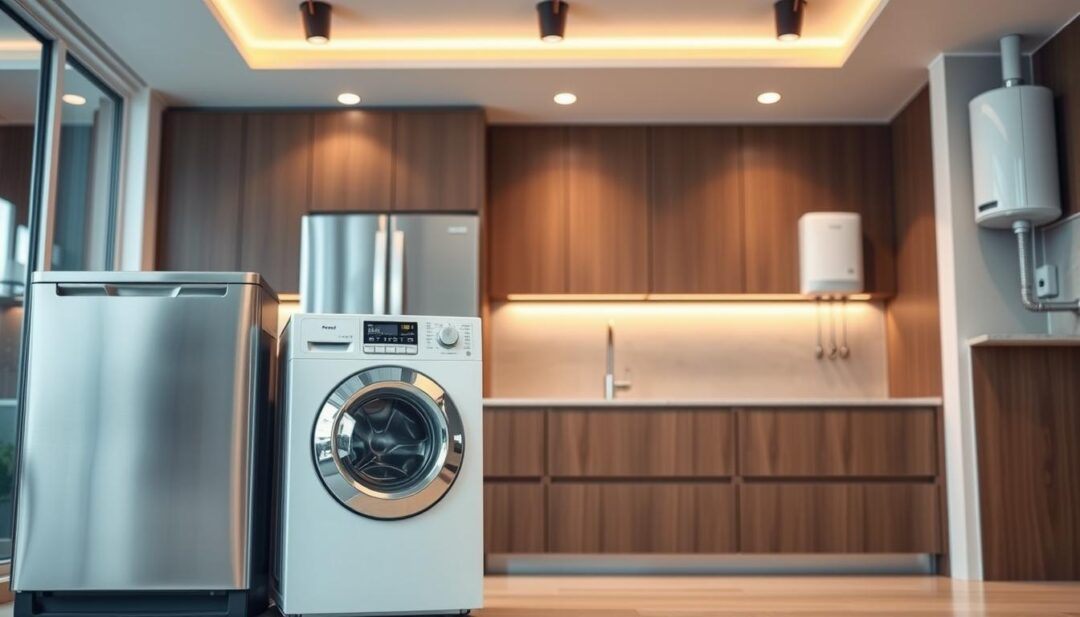
Detecting and Fixing Household Leaks
Finding and fixing leaks is key to reducing water usage at home. Leaks can happen anywhere in the house. They often go unnoticed until they cause a lot of damage.
Common Leak Locations
Leaks often happen in moist areas or where things wear out fast. You’ll find them in toilets, faucets, and under sinks.
Toilet and Faucet Inspections
Toilets can leak a lot, wasting up to 200,000 liters of water a year. Faucets also leak if not kept in good shape.
Hidden Pipe Leakage Signs
Hidden leaks show up as water damage, warped floors, and higher water bills. Catching these early can save a lot of trouble.
DIY Leak Detection Methods
Homeowners can use simple DIY ways to find leaks. One good method is water meter monitoring.
Water Meter Monitoring Technique
Check the water meter when no water is being used. If it’s still moving, you have a leak somewhere.
When to Call a Professional
While DIY methods work, some leaks need a pro. If you’re not sure about a leak or how to fix it, get a plumber. This prevents more damage.
Being proactive about leaks helps save water and money. It’s a smart move for any homeowner.
Smart Home Technology for Water Management
Smart home tech is changing the game for eco-friendly practices and efficient water management. Homeowners can now use advanced devices to better monitor and control their water use.
Water Monitoring Systems
Water monitoring systems are key for spotting leaks and odd water use patterns. They give real-time data on how much water is being used. This helps homeowners find ways to use less water.
Latest Leak Detection Devices
Today’s leak detection devices can find even tiny leaks, stopping big water waste. For example, FlowSense can spot leaks and send alerts to your phone.
Mobile App Integration
Many water monitoring systems have mobile apps. This lets homeowners check their water use from anywhere and get alerts about problems.
Automated Irrigation Controllers
Automated irrigation controllers adjust watering based on the weather. This ensures plants get the right amount of water. Energy Saver says these controllers can cut outdoor water use a lot.
Weather-Responsive Systems
Weather-responsive systems adjust watering based on current weather. They help use water more efficiently.
Smart Shower Systems
Smart shower systems aim to use less water during showers. They limit water flow and show how much water you’re using in real time.
Flow Regulation Technology
Flow regulation technology in smart showers keeps water flow steady while using less water overall.
| Feature | Smart Water Monitoring | Automated Irrigation | Smart Shower Systems |
|---|---|---|---|
| Real-time Monitoring | Yes | No | Yes |
| Leak Detection | Yes | No | No |
| Water Savings | Up to 20% | Up to 30% | Up to 15% |
Using these smart home technologies can greatly cut down water use. This helps with smart water habits every homeowner should know and supports eco-friendly water practices.
Financial Incentives for Water Conservation
Homeowners can cut their water bills by using water-saving methods. The U.S. has many programs to help, like rebates and tax breaks. These programs encourage using water wisely.
Federal and State Rebate Programs
The federal government and states offer rebates for water-saving items. These programs aim to lower water use across the country.
2025 Available Incentives
In 2025, homeowners can get rebates for water-efficient products. For example, the WaterSense program gives rebates for WaterSense labeled items. These items save a lot of water.
| Program | Description | Rebate Amount |
|---|---|---|
| WaterSense | Rebates for WaterSense labeled products | Up to $200 |
| State Rebate Programs | Varies by state; check local listings | Up to $500 |
Utility Company Discounts
Utility companies give discounts for water-saving actions. They offer deals on water-efficient appliances or rebates for rainwater systems.
Participation Requirements
To get these discounts, homeowners must buy and install approved devices. Some companies also check if the devices are installed correctly.
Tax Benefits for Water-Efficient Homes
Upgrading to water-efficient homes can also get you tax benefits. These benefits can help pay for new appliances and fixtures.
Qualification Criteria
To qualify, homes must meet water efficiency standards. This is often checked through a home audit or by using WaterSense labeled products. For more on tax credits, visit www.energysavers.gov/taxcredits.
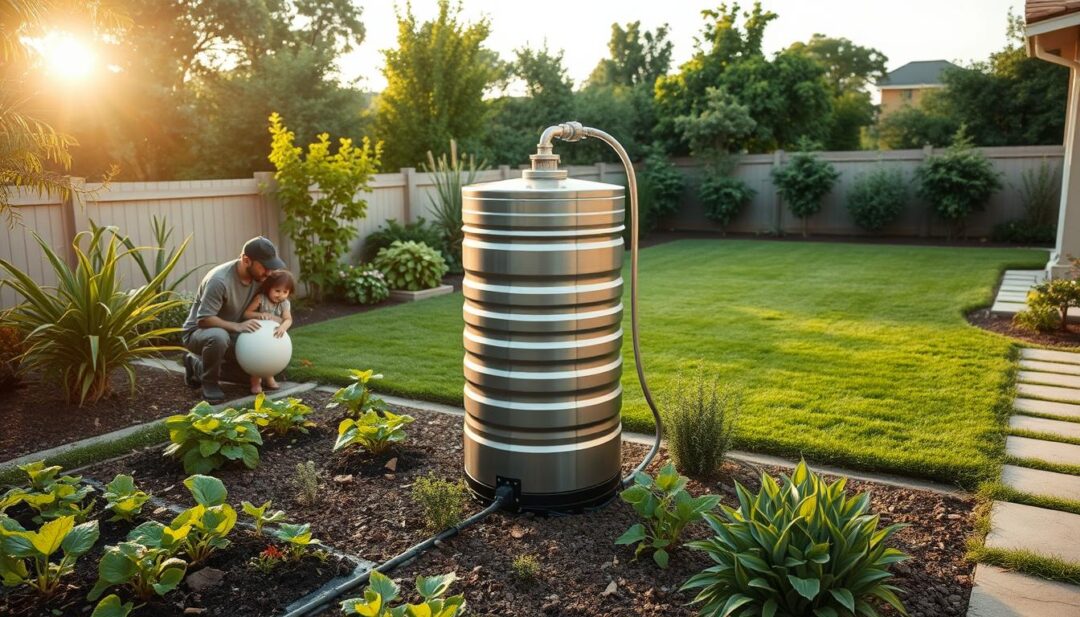
Using these incentives, homeowners can save on water bills and help the planet. It’s key to look into local programs and use rebates and tax benefits to make saving water easier.
Community Water Conservation Initiatives
Water scarcity is a big problem now. Communities all over America are working together to save water. They are using smart ways to cut down on water use.
Neighborhood Water-Saving Programs
Many neighborhoods are starting water-saving programs. For example, York Region’s Water for Tomorrow program has saved a lot of water. They’ve saved an average of 26 million liters every day.
Success Stories Across America
Communities all over the country are saving water together. Their success stories are helping other places learn how to save water too.
Educational Resources
Learning how to save water is important. Communities are giving out resources to teach people how to use water wisely.
Local Workshops and Online Courses
There are workshops and online courses to teach people about using water well. These help people develop water-efficient habits.
Municipal Conservation Mandates
Municipalities are making rules to save water. They want everyone to follow these rules to help save water.
Compliance Guidelines
People are being told how to follow these rules. There are clear guidelines and rewards for those who do.
Here is a summary of community water conservation initiatives in a tabular form:
| Initiative Type | Description | Benefits |
|---|---|---|
| Neighborhood Programs | Community-led water conservation efforts | Significant water savings |
| Educational Resources | Workshops and online courses on water conservation | Increased awareness and adoption of water-efficient practices |
| Municipal Mandates | Regulations and guidelines for water conservation | Ensured compliance and reduced water waste |
Long-Term Water Management Planning
Planning for water use over the long term is key for homes. It helps cut down water use and makes communities more water-efficient. Homeowners play a big role in this.
Creating a Home Water Audit
Starting with a home water audit is the first step. It spots where water is wasted and where you can save. The U.S. Department of Energy says a water audit can find leaks and save a lot of water (www.energysavers.gov/publications).
Step-by-Step Assessment Process
- Inspect all faucets, toilets, and appliances for leaks.
- Check your water meter to detect hidden leaks.
- Monitor your water bill for unusual consumption patterns.
Setting Reduction Goals
Once you know where to improve, set goals for water use. These goals should match your household’s needs and size.
Realistic Benchmarks by Household Size
| Household Size | Average Daily Water Use (gallons) | Target Reduction |
|---|---|---|
| 1-2 people | 50-100 | 10% |
| 3-4 people | 100-200 | 15% |
| 5+ people | 200+ | 20% |
Tracking Progress Over Time
It’s important to keep track of your water use. Use digital tools to monitor your water in real-time.
Digital Monitoring Tools
Smart water systems alert you to leaks and odd usage. They help you meet your water use goals. These tools guide you in using water wisely.
Conclusion: Building a Water-Conscious Household
Households can cut down a lot on water by using water wisely. By following the water conservation tips from this guide, homes can become more eco-friendly and use water better. Simple changes in daily habits can make a big difference.
To make a home water-conscious, start with small steps and bigger changes. Installing water-saving devices and using rainwater are good ideas. These actions help a lot in making our planet greener.
Working towards a water-efficient home is a long-term effort. It’s important to keep track of how much water you use. By doing this, you can always find ways to use less. With the right approach, every home can help save water and contribute to a better future.

